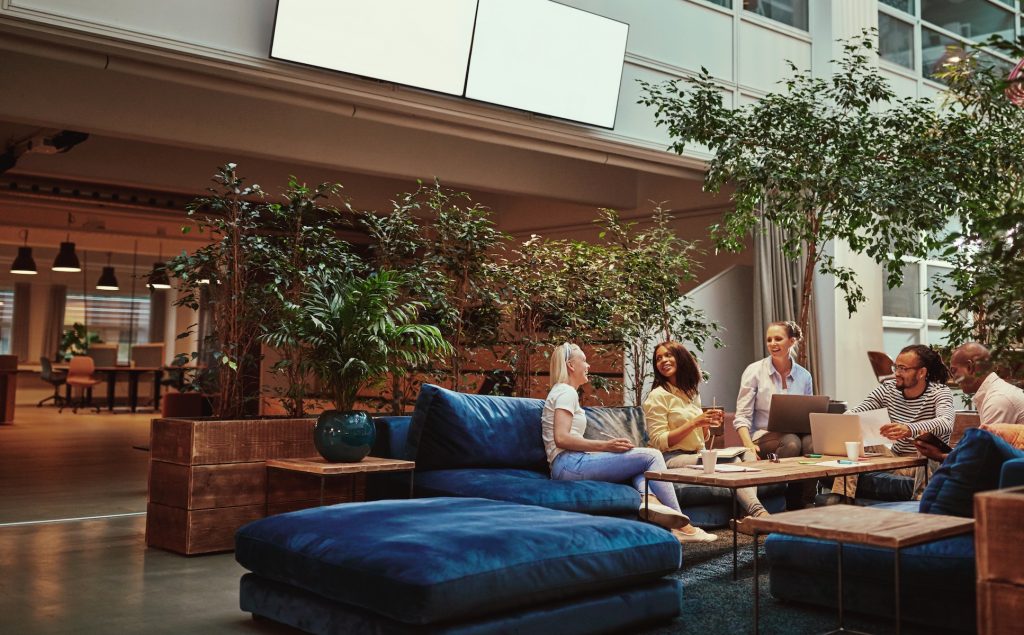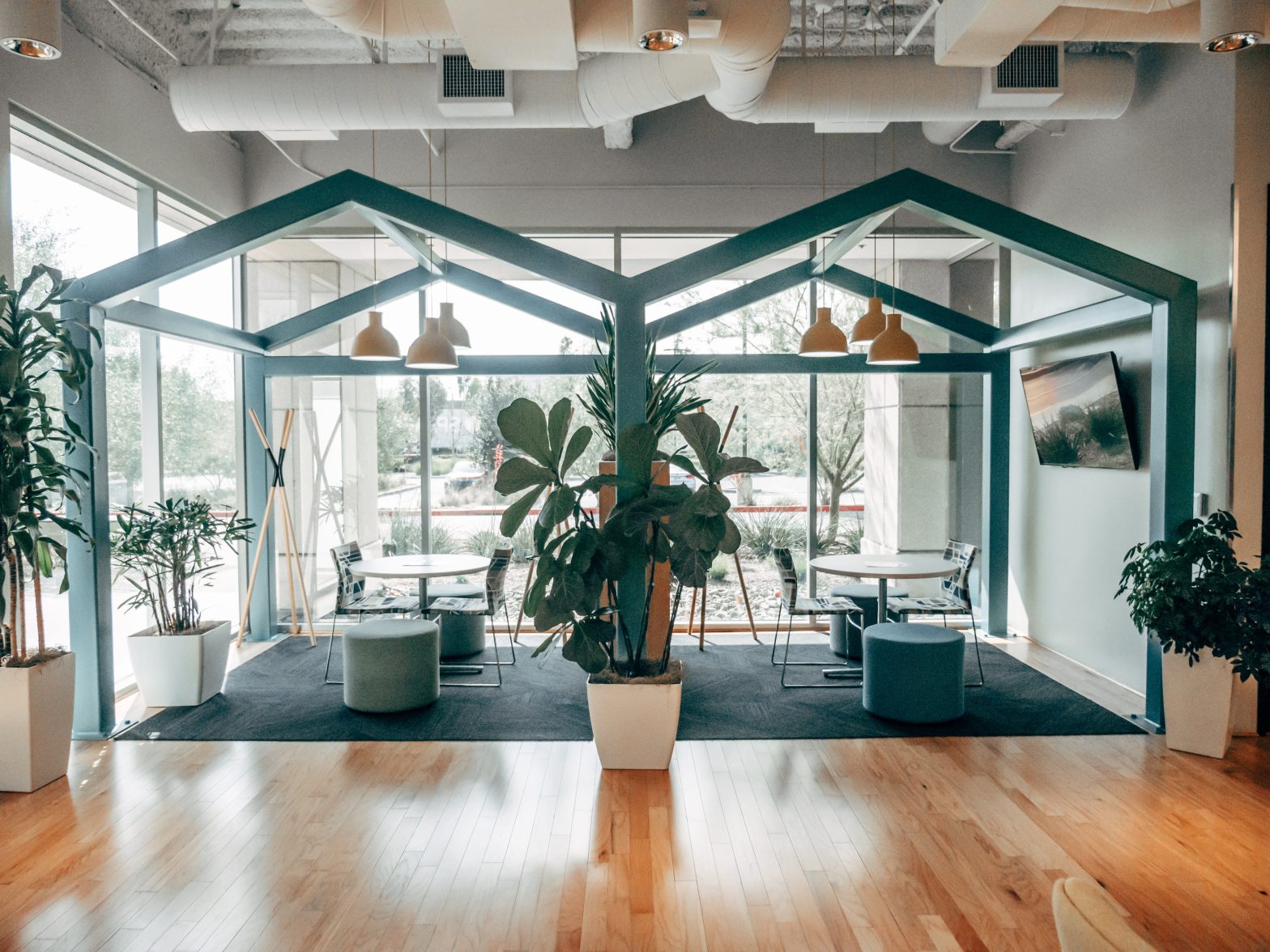ROOM’s VP of Workspace Design & Strategy Alejandra Albarrán outlines how innovative design will convince far more employees to return to the office than vaccines alone.
How are we going to work when the post-COVID dust finally settles? At ROOM, it’s a question that we’ve been asking ourselves since the working world was thrust into working from home with little to no warning. What was the default of wake up and go to the office, suddenly became wake up and go to the couch, or kitchen table, or at-home desk, if lucky.
Before COVID, remote work was already accelerating with over five million employees in the U.S. working remotely as of 2018. Then, working from home felt like a luxury to those that were allowed the freedom and choice to do so. While it may have also felt that way to many at the start of the lockdown, being forced to have work move in with us full-time, has proven not to be the ideal situation we once thought it was.
Shortly after the Worldwide Health Association (WHO) declared a global pandemic, studies showed that at least 75% of people wanted to go back to working from an office, at least a few days a week. These thoughts will eventually settle on a sustainable new normal, likely a hybrid workforce and distributed workplace where people can have the best of both working worlds.
Now, more than ever, people see the benefits of the office – company culture is found in the small day-to-day interactions with our teammates – but have also gotten first-hand experience with what it’s like to work from home. Perhaps the most fundamental shift moving forward is that going to the office will be a conscious decision. With the ability to choose how and where we work, the role of the workplace in a post-COVID-19 world will be more important than ever.
Companies that attempt to return to the office in a manner similar to the way things were before COVID will likely struggle. Now is the time to reinvent the workplace. By looking at the office as a place of unity, we can reshape the workplace to maximize human connection, one of the most powerful tools of any organization. At ROOM, we envision vibrant workplaces that are purpose-built to foster collaboration and productivity, ultimately creating a new way of working. Spaces that deliver a better experience for users, and are more technologically advanced.
The “new normal” isn’t necessarily a world without the office, it’s a world where we focus on how we work instead of where we work. The successful workspace of the future will be based on the element of choice, designing for adaptability, creating inspirational spaces that people want to spend time in, and merging virtual and in-person collaboration.

1. Design to offer choice
What we know as “work” encompasses many types of activities, from tasks that require focused concentration, to making calls and writing emails, to collaborating, brainstorming or casual social encounters with colleagues. So while we need private space, we also need different types of functional zones to create a healthy flow in a balanced workplace ecosystem.
Today more than ever, people want autonomy and freedom. They want to choose for themselves the best way to do their best work. That means owning the decision between being remote, in person, or a hybrid of the two. The threshold of safety becomes a personal choice. Workspaces should offer possibilities rather than prescribing how employees should work.
To have a successful workspace today means we must provide a variety of settings in one office environment. Meeting rooms, creative hubs, wellness rooms and break out areas are just some of the few key environments you need. We need spaces for in-person and virtual meetings for 2-4 people, with and without walls, focus nooks, quiet zones, private offices, and so on.
2. Design for Flexibility
We need to break the old paradigms driven by density and cost and start thinking about creating adaptive and flexible workspaces. Fixed permanent floor plans become an obstacle for both companies and real estate developers. The future of a successful workplace is reliant on the speed in which it can adapt to the needs of the people who inhabit it.
Work environments designed with fixed architecture and furniture must shift to become more fluid. No one knows what the future holds and disruption is a given, whether it’s another lockdown, changing real estate costs, or new advances in technology.
Organizations need spaces that can change rapidly and easily. There is a huge advantage in the ability to morph spaces to new uses in a short period of time and the ability to react to behavior and social interactions. These attributes are empowering employees to adapt spaces based on the type of work they need to do and the level of privacy they need to do it.
Hybrid spaces create unplanned situations, disrupt habits and expectations. They allow cross pollination, encourage an open mind, create new paths and new encounters, and embrace the unexpected. Examples like hybrid large conference rooms with modular furniture that can be a meeting room, a creative lab, or a breakout room, and can be transformed on an hour-to-hour basis, will be key.

3. Design for Inspiration
Space has an enormous impact on how we feel. We absorb the world through our senses, which means that we feel before we think.
The office is developing into an enabler of experiences that connect us in a deeper, more human way with our teams. In the future, it will be about making work even more meaningful when we come together, by designing for opportunities where people can connect. Work is no longer just about production, but about identity: having purpose, being seen and being recognized. As designers, founders, and managers, we should be focused on providing serendipitous settings that enable deeper human connections and experiences.
It’s important to create workplaces that improve team connectivity as it will continue to be one of the most powerful tools an organization can use to improve productivity, along with attracting and keeping top talent.
Re-inventing our workspaces to bring a more inviting presence will be top priority. A space can be beautiful, but without human warmth it can be the loneliest place in the world. We will get together to create and innovate, to collaborate and interact. As great ideas can’t be scheduled, it is our job as designers and architects, to design spaces that provide a variety of desirable environments. Places that attract different people, different ideas, and different experiences.
It will be extremely important to find ways to bring people into the office, even in hybrid setups. It’s not only about having a great workplace, it’s about providing a variety of reasons for people to take the journey into the office and engage in experiences with their peers.
4. Design physical spaces that support virtual and in-person connection
Coming out of this crisis, organizations may decide that it makes sense to keep some teams working remotely. This will result in fewer in-person meetings and more cross-departmental video calls. Technology-enabled, purpose-built rooms featuring state-of-the-art video conferencing will be a necessity. Integrating such spaces into the workplace will simultaneously increase the availability of private workspaces like phone booths and privacy pods, which offer acoustic and visual privacy for quick video calls or focused, heads down work.
Adapting to a hybrid and distributed workforce will come with a full set of new challenges, however, the role of the office as a centralized environment for organizational culture and experience remains. Beyond creating a functional work environment, designers must now take care to accommodate the virtual working experience.
How do we grow from here? The truth is that a new way of working was already on its way before COVID hit, which has only accelerated the timeline for much-needed change. Today, after experiencing a different way to work, we are even more certain of the true functions and requirements of workspaces. How we will work in the future is up to all of us, and we are eager and inspired to create inviting, productive environments for the next generation of the workforce.
